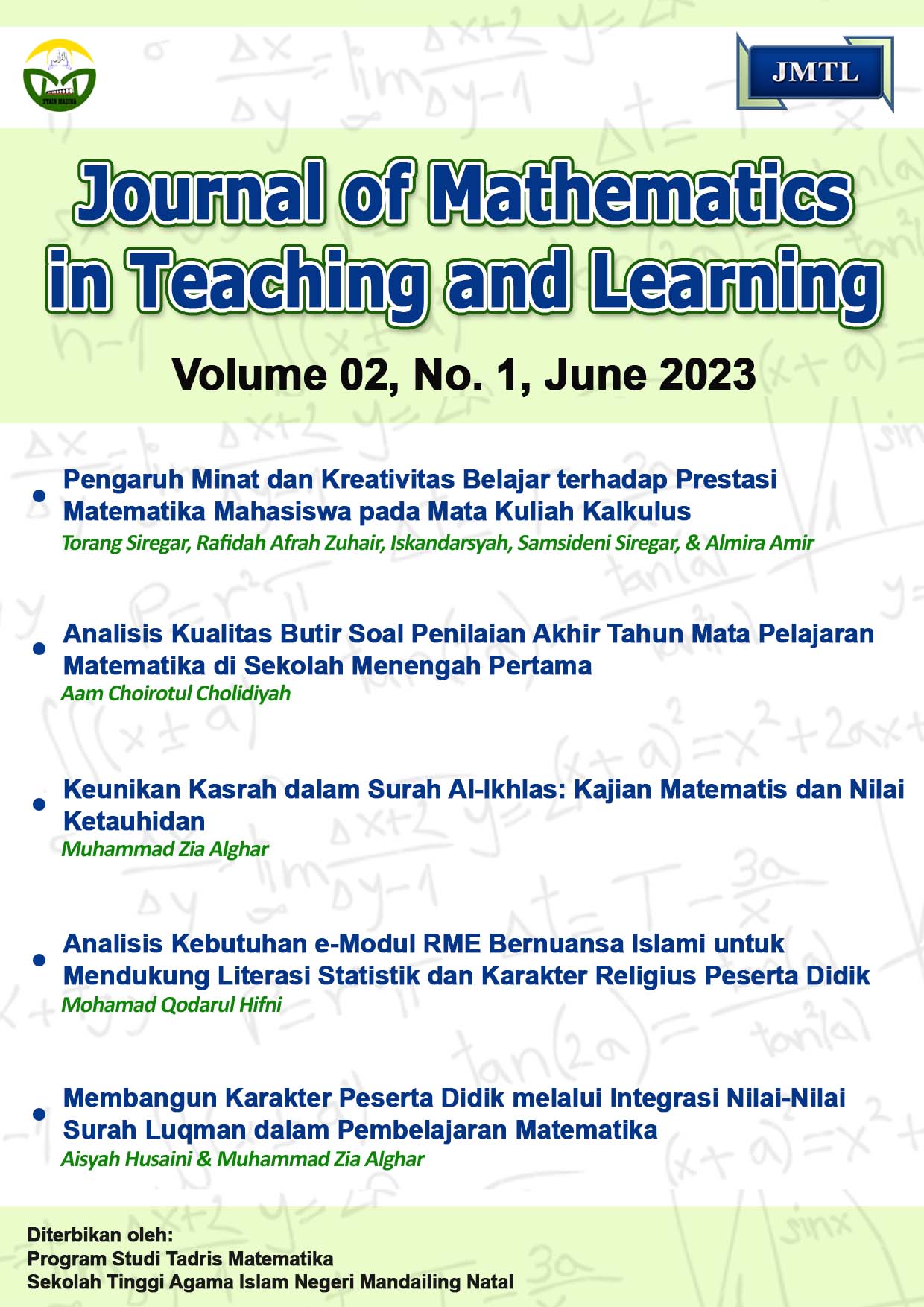Pengaruh Minat dan Kreativitas Belajar terhadap Prestasi Matematika Mahasiswa pada Mata Kuliah Kalkulus
Keywords:
Hasil Belajar, model pembelajaran Minat dan KreativitasAbstract
Penelitian ini bertujuan untuk menganalisis pengaruh minat dan kreativitas belajar terhadap prestasi mahasiswa pada mata kuliah Kalkulus secara parsial dan simultan. Penelitian ini menggunakan desain ex post facto dengan pendekatan korelasional. Penelitian dilaksanakan di Universitas Negeri Medan. Sampel berjumlah 30 mahasiswa yang dipilih dengan teknik random sampling. Data diperoleh melalui tiga instrumen, yaitu tes hasil belajar Kalkulus, angket minat belajar, dan angket kreativitas belajar. Analisis data dilakukan secara deskriptif dan inferensial menggunakan regresi linear berganda. Hasil penelitian menunjukkan bahwa: (1) minat belajar berpengaruh signifikan terhadap prestasi Kalkulus (t hitung = 4,392 > t tabel = 1,669), (2) kreativitas belajar berpengaruh signifikan terhadap prestasi Kalkulus (t hitung = 3,102 > t tabel = 1,669), dan (3) minat dan kreativitas belajar secara bersama-sama berpengaruh positif dan signifikan terhadap prestasi Kalkulus (p < 0,05). Model regresi yang diperoleh yaitu Y=22,044+0,502X1+0,120X2, yang menunjukkan bahwa peningkatan minat dan kreativitas belajar akan diikuti oleh peningkatan prestasi kalkulus mahasiswa. Temuan ini menegaskan bahwa peningkatan minat dan kreativitas belajar dapat mendukung pencapaian prestasi akademik yang lebih baik pada mata kuliah Kalkulus.
References
Bluman, A. (2014). Elementary Statistics: A step by step approach 9e. McGraw Hill.
de Vink, I. C., Willemsen, R. H., Lazonder, A. W., & Kroesbergen, E. H. (2022). Creativity in mathematics performance: The role of divergent and convergent thinking. British Journal of Educational Psychology, 92(2), 484–501. https://doi.org/10.1111/bjep.12459
DiDonato, N. C. (2015). Theology as “queen of science” reconsidered: A basis for scientific realism. Theology and Science, 13(4), 409–424. https://doi.org/10.1080/14746700.2015.1082874
Ennis, T. D., Sullivan, J. F., Louie, B., & Knight, D. (2013). Unlocking the gate to calculus success: Pre-calculus for engineers-an assertive approach to readying underprepared students. 2013 ASEE Annual Conference & Exposition, 23–1285. https://doi.org/10.18260/1-2--22670
Gabriel, F., Buckley, S., & Barthakur, A. (2020). The impact of mathematics anxiety on self-regulated learning and mathematical literacy. In Australian Journal of Education (Vol. 64, Issue 3, pp. 227–242). https://doi.org/10.1177/0004944120947881
Hidayat, P. W., & Widjajanti, D. B. (2018). Analisis kemampuan berpikir kreatif dan minat belajar siswa dalam mengerjakan soal open ended dengan pendekatan CTL. Pythagoras: Jurnal Matematika Dan Pendidikan Matematika, 13(1), 63–75. https://doi.org/10.21831/pg.v13i1.21167
Ida, F. M., & Maksum, H. (2020). Contribution of Learning Style, Learning Creativity and Exploratory Interest to Students’ Simulation and Digital Communication Learning Outcomes during the Covid-19 Pandemic. Journal of Education Technology, 4(4), 404–414. https://doi.org/10.23887/jet.v4i4.29701
Kakarndee, N., Kudthalang, N., & Jansawang, N. (2018). The integrated learning management using the STEM education for improve learning achievement and creativity in the topic of force and motion at the 9th grade level. AIP Conference Proceedings, 1923(1), 30024. https://doi.org/10.1063/1.5019515
Kemendikbud. (2017). Peraturan Menteri Pendidikan dan Kebudayaan tentang Penilaian Hasil Belajar oleh Pemerintah dan Penilaian Hasil Belajar oleh Satuan Pendidikan. Kemendikbud.
Kögce, D. (2022). Examination of Mathematical Errors and Mistakes in Calculus Course. Educational Policy Analysis and Strategic Research, 17(1), 295–311.
Kozlowski, J. S., & Si, S. (2019). Mathematical creativity: A vehicle to foster equity. Thinking Skills and Creativity, 33, 100579. https://doi.org/10.1016/j.tsc.2019.100579
Lin, C.-H. (2022). Use progressive visualization teaching method to improve learning motivation of calculus courses. The European Journal of Social & Behavioural Sciences, 31(2), 92–110. https://doi.org/10.15405/ejsbs.315
Matthews, A. R., Hoessler, C., Jonker, L., & Stockley, D. (2013). Academic motivation in calculus. Canadian Journal of Science, Mathematics and Technology Education, 13(1), 1–17. https://doi.org/10.1080/14926156.2013.758328
Moru, E. K., Qhobela, M., Wetsi, P., & Nchejane, J. (2014). Teacher knowledge of error analysis in differential calculus. Pythagoras, 35(2), 1–10.
Mullis, M., Gadermann, A., & Wu, A. D. (2016). Trends in International Mathematics and Science Study (TIMSS). Encyclopedia of Quality of Life and Well-Being Research, 6737–6739. https://doi.org/10.1007/978-94-007-0753-5_3063
O’Keeffe, L., & Paige, K. (2021). Re-highlighting the potential of critical numeracy. Mathematics Education Research Journal, 33(2), 285–299. https://doi.org/10.1007/s13394-019-00297-8
Retnawati, H. (2022). Empirical Study of Factors Affecting the Students’ Mathematics Learning Achievement. International Journal of Instruction, 15(2), 417–434. https://doi.org/10.29333/iji.2022.15223a
Sarwandianto, A., Alamsyah, N., Wulan, R., & Awaludin, A. A. R. (2020). Relationship between creativity and learning style and mathematics learning achievement of elementary school students. AIP Conference Proceedings, 2215(1), 60027. https://doi.org/10.1063/5.0001018
Sirait, E. D. (2016). Pengaruh minat belajar terhadap prestasi Belajar Matematika. Formatif: Jurnal Ilmiah Pendidikan MIPA, 6(1), 35–43. https://doi.org/10.30998/formatif.v6i1.750
Sriraman, B. (2005). Are giftedness and creativity synonyms in mathematics? Journal of Secondary Gifted Education, 17(1), 20–36.
Sternberg, R. J., & Sternberg, K. (2017). Cognitive Psychology (7th ed.). Wadsworth Cengage Learning.
Tambunan, H. (2018). The Dominant Factor of Teacher’s Role as a Motivator of Students’ Interest and Motivation in Mathematics Achievement. International Education Studies, 11(4), 144–151. https://doi.org/10.5539/ies.v11n4p144
Tashtoush, M., Alshunaq, M., & Albarakat, A. (2020). The Effectiveness of self-regulated learning (SRL) in creative thinking for calculus students. PalArch’s Journal of Archaeology of Egypt/Egyptology, 17(7), 6630–6652.
Walpole, R. E., Myers, R. H., Myers, S. L., & Ye, K. (1993). Probability and statistics for engineers and scientists (5th ed.). Macmillan New York.
Downloads
Published
How to Cite
Issue
Section
License
Copyright (c) 2023 Torang Siregar

This work is licensed under a Creative Commons Attribution-NonCommercial-ShareAlike 4.0 International License.







